Founded in 1938 and published semiannually by Sophia University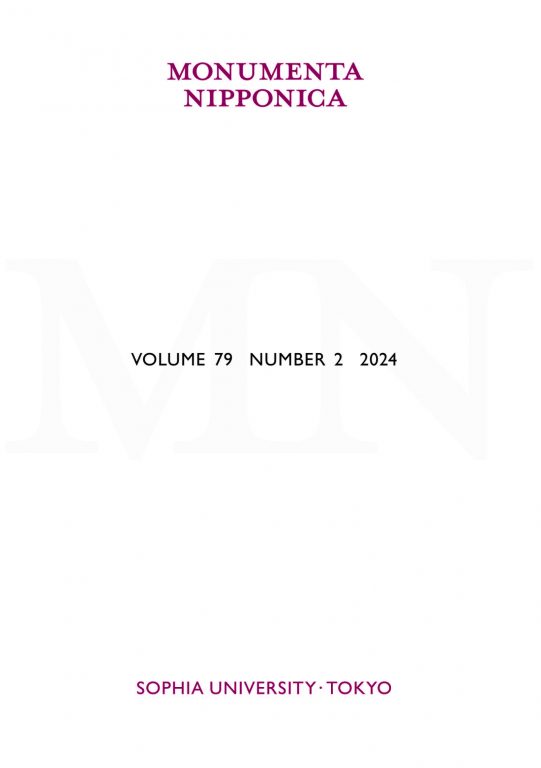 MN 79:2 (2024) 288–93Overseas Shinto Shrines: Religion, Secularity and the Japanese Empire by Karli ShimizuSuga Kōji
MN 79:2 (2024) 288–93Overseas Shinto Shrines: Religion, Secularity and the Japanese Empire by Karli ShimizuSuga Kōji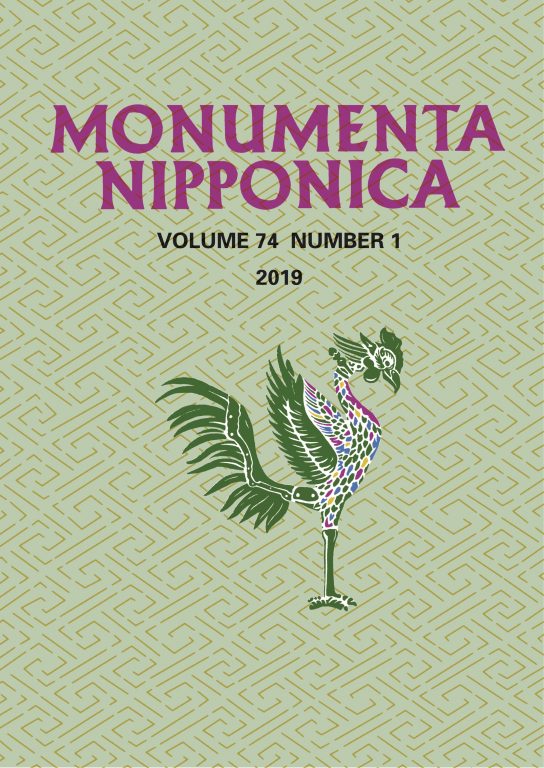 MN 74:1 (2019) 59–84The Poetics of Nativism: Motoori Norinaga and the Sacralization of Japanese LiteratureEmi Foulk Bushelle
MN 74:1 (2019) 59–84The Poetics of Nativism: Motoori Norinaga and the Sacralization of Japanese LiteratureEmi Foulk Bushelle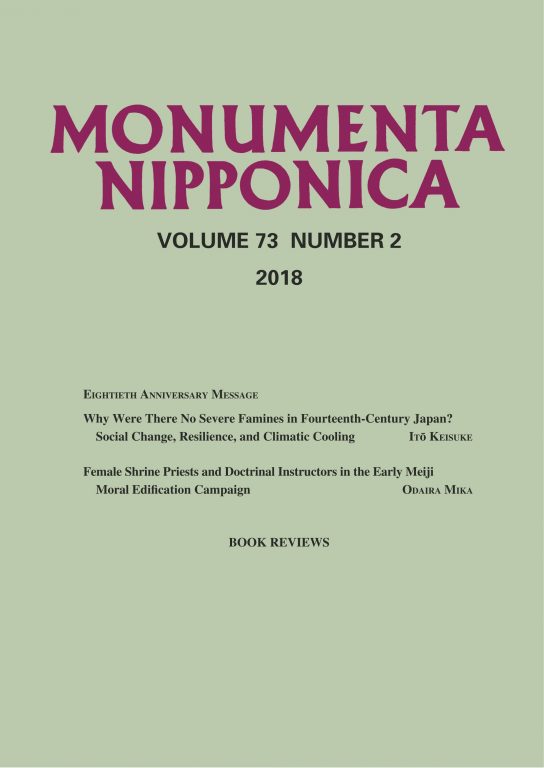 MN 73:2 (2018) 213–44Female Shrine Priests and Doctrinal Instructors in the Early Meiji Moral Edification CampaignMichael Burtscher and Mika Odaira
MN 73:2 (2018) 213–44Female Shrine Priests and Doctrinal Instructors in the Early Meiji Moral Edification CampaignMichael Burtscher and Mika Odaira MN 66:1 (2011) 123–45“State Shinto” in Recent Japanese ScholarshipMichiaki Okuyama
MN 66:1 (2011) 123–45“State Shinto” in Recent Japanese ScholarshipMichiaki Okuyama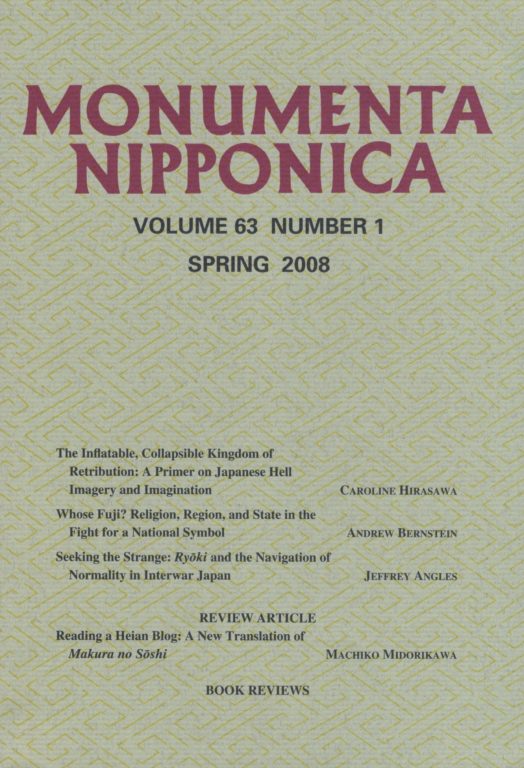 MN 63:1 (2008) 51–99Whose Fuji?: Religion, Region, and State in the Fight for a National SymbolAndrew Bernstein
MN 63:1 (2008) 51–99Whose Fuji?: Religion, Region, and State in the Fight for a National SymbolAndrew Bernstein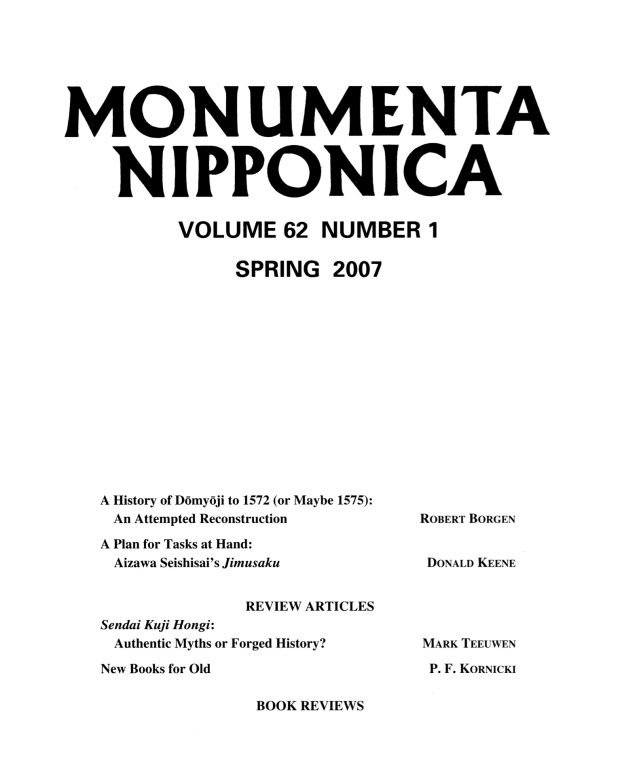 MN 62:1 (2007) 1–74A History of Dōmyōji to 1572 (or Maybe 1575): An Attempted ReconstructionRobert Borgen
MN 62:1 (2007) 1–74A History of Dōmyōji to 1572 (or Maybe 1575): An Attempted ReconstructionRobert Borgen MN 62:1 (2007) 56–74DōmyōjiTranslated by Robert Borgen
MN 62:1 (2007) 56–74DōmyōjiTranslated by Robert Borgen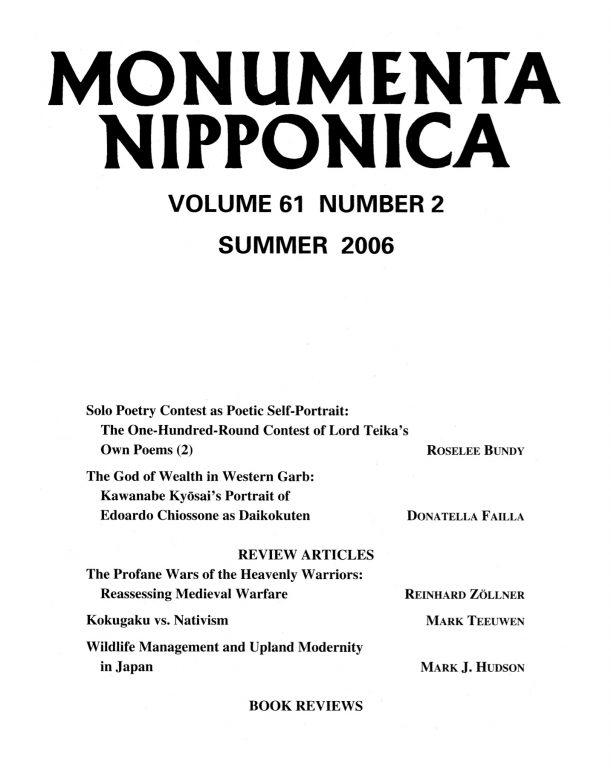 MN 61:2 (2006) 227–42Kokugaku vs. NativismMark Teeuwen
MN 61:2 (2006) 227–42Kokugaku vs. NativismMark Teeuwen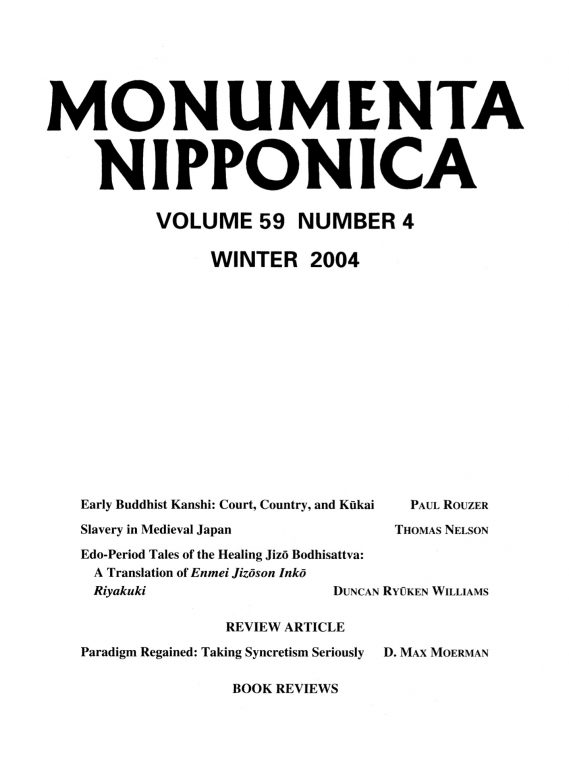 MN 59:4 (2004) 525–533Paradigm Regained: Taking Syncretism SeriouslyD. Max Moerman
MN 59:4 (2004) 525–533Paradigm Regained: Taking Syncretism SeriouslyD. Max Moerman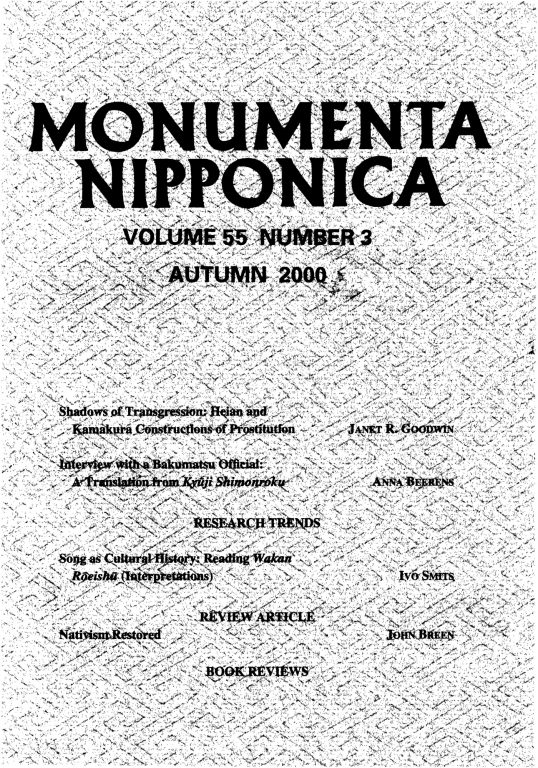 MN 55:3 (2000) 429–39Nativism RestoredJohn Breen
MN 55:3 (2000) 429–39Nativism RestoredJohn Breen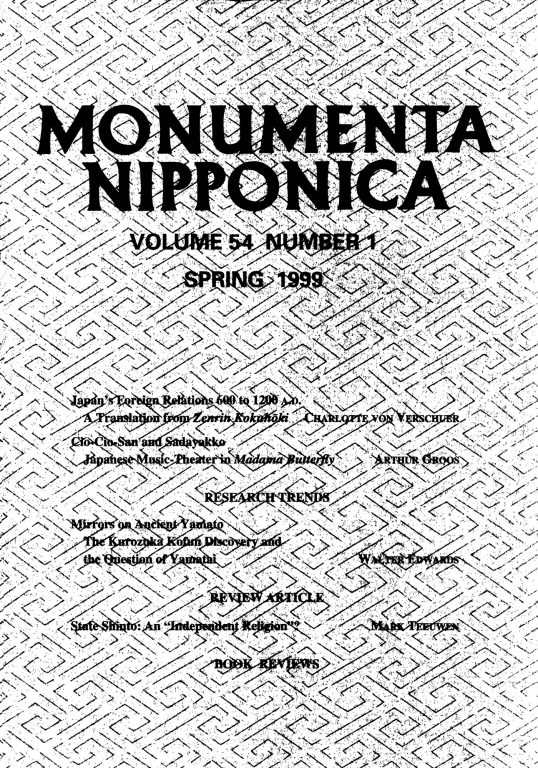 MN 54:1 (1999) 111–21State Shinto: An “Independent Religion”?Mark Teeuwen
MN 54:1 (1999) 111–21State Shinto: An “Independent Religion”?Mark Teeuwen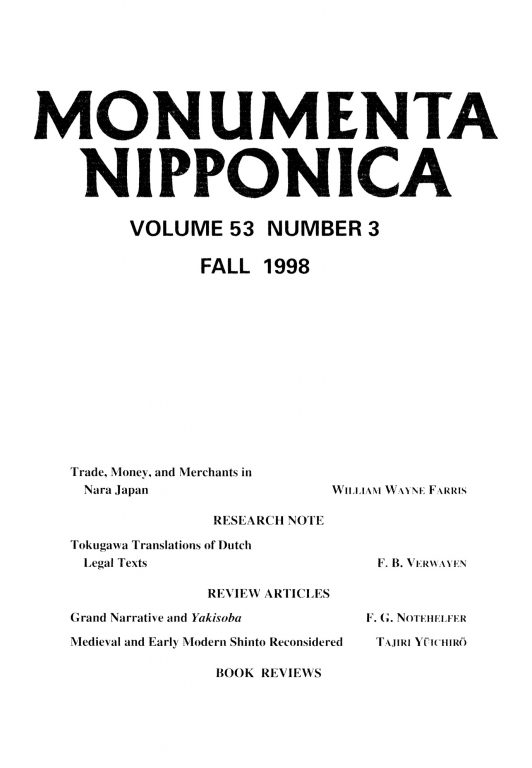 MN 53:3 (1998) 375–81Medieval and Early Modern Shinto ReconsideredYūichirō Tajiri
MN 53:3 (1998) 375–81Medieval and Early Modern Shinto ReconsideredYūichirō Tajiri MN 52:3 (1997) 295–325Poetry, Sake, and Acrimony: Arakida Hisaoyu and the Kokugaku MovementMark Teeuwen
MN 52:3 (1997) 295–325Poetry, Sake, and Acrimony: Arakida Hisaoyu and the Kokugaku MovementMark Teeuwen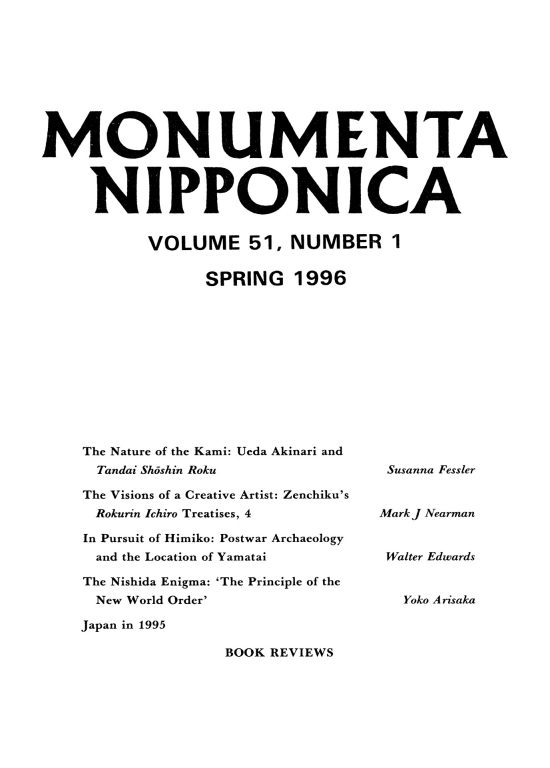 MN 51:1 (1996) 1–15The Nature of the Kami: Ueda Akinari and Tandai Shōshin RokuSusanna Fessler
MN 51:1 (1996) 1–15The Nature of the Kami: Ueda Akinari and Tandai Shōshin RokuSusanna Fessler MN 51:1 (1996) 8–15Selections from Tandai Shōshin RokuAkinari Ueda, Translated by Susanna Fessler
MN 51:1 (1996) 8–15Selections from Tandai Shōshin RokuAkinari Ueda, Translated by Susanna Fessler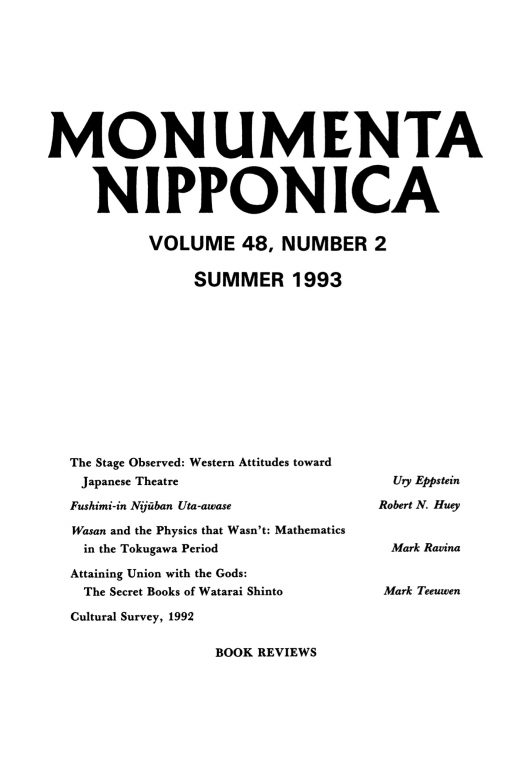 MN 48:2 (1993) 225–45Attaining Union with the Gods: The Secret Books of Watarai ShintoMark Teeuwen
MN 48:2 (1993) 225–45Attaining Union with the Gods: The Secret Books of Watarai ShintoMark Teeuwen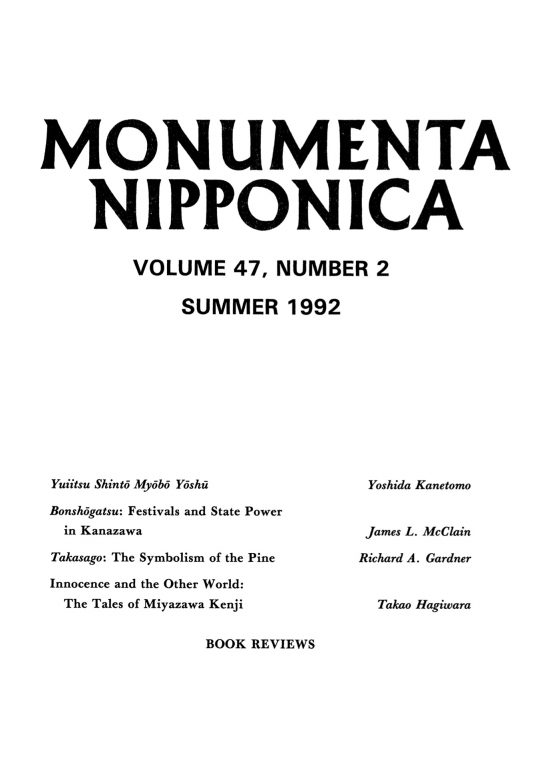 MN 47:2 (1992) 137–61Yuiitsu Shintō Myōbō Yōshū (Part 2)Yoshida Kanetomo, Translated by Allan G. Grapard
MN 47:2 (1992) 137–61Yuiitsu Shintō Myōbō Yōshū (Part 2)Yoshida Kanetomo, Translated by Allan G. Grapard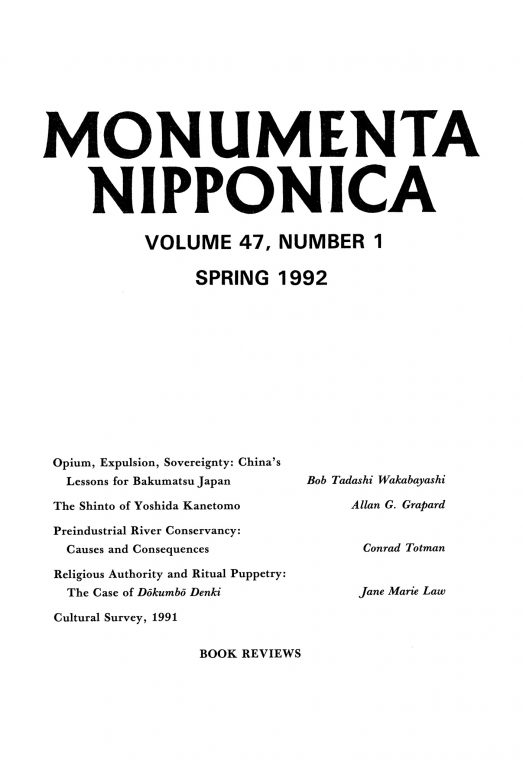 MN 47:1 (1992) 27–58The Shinto of Yoshida Kanetomo (Part 1)Allan G. Grapard
MN 47:1 (1992) 27–58The Shinto of Yoshida Kanetomo (Part 1)Allan G. Grapard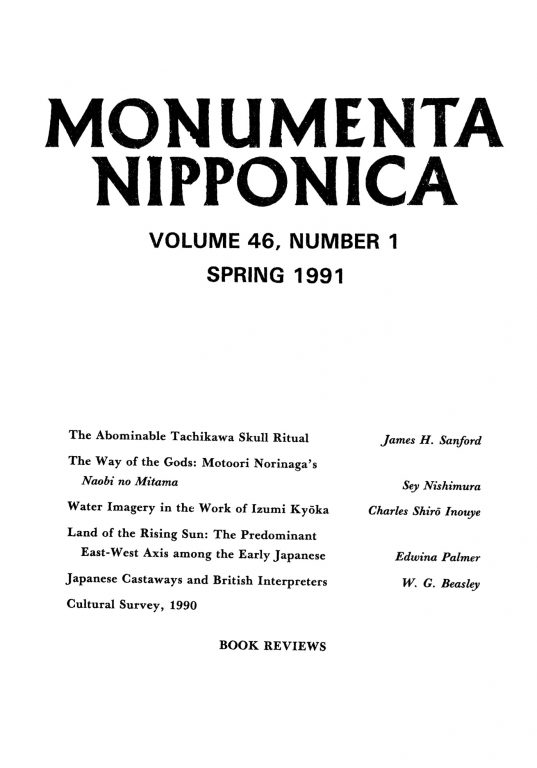 MN 46:1 (1991) 21–41The Way of the Gods: Motoori Norinaga’s Naobi no MitamaSey Nishimura
MN 46:1 (1991) 21–41The Way of the Gods: Motoori Norinaga’s Naobi no MitamaSey Nishimura MN 46:1 (1991) 27–41Naobi no MitamaMotoori Norinaga, Translated by Sey Nishimura
MN 46:1 (1991) 27–41Naobi no MitamaMotoori Norinaga, Translated by Sey Nishimura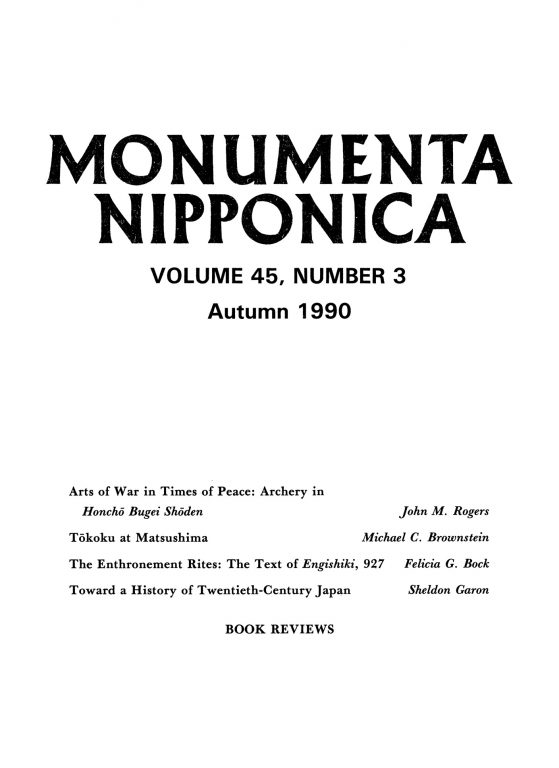 MN 45:3 (1990) 307–37The Enthronement Rites: The Text of Engishiki, 927Translated by Felicia Gressitt Bock
MN 45:3 (1990) 307–37The Enthronement Rites: The Text of Engishiki, 927Translated by Felicia Gressitt Bock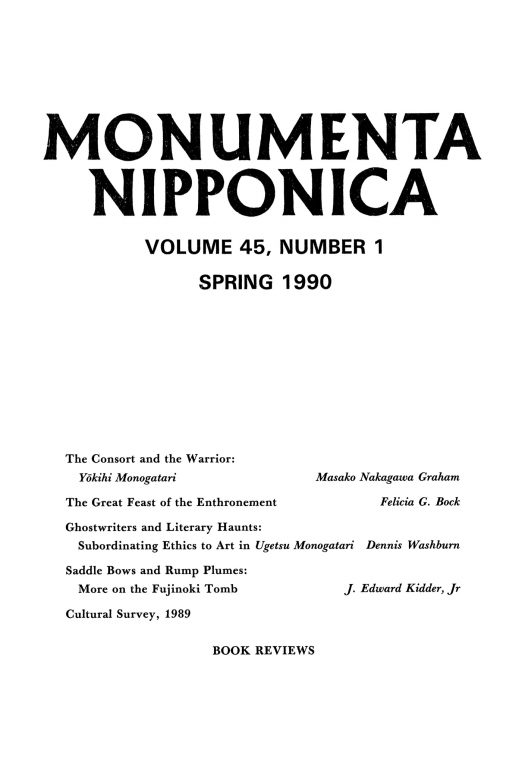 MN 45:1 (1990) 27–38The Great Feast of the EnthronementFelicia Gressitt Bock
MN 45:1 (1990) 27–38The Great Feast of the EnthronementFelicia Gressitt Bock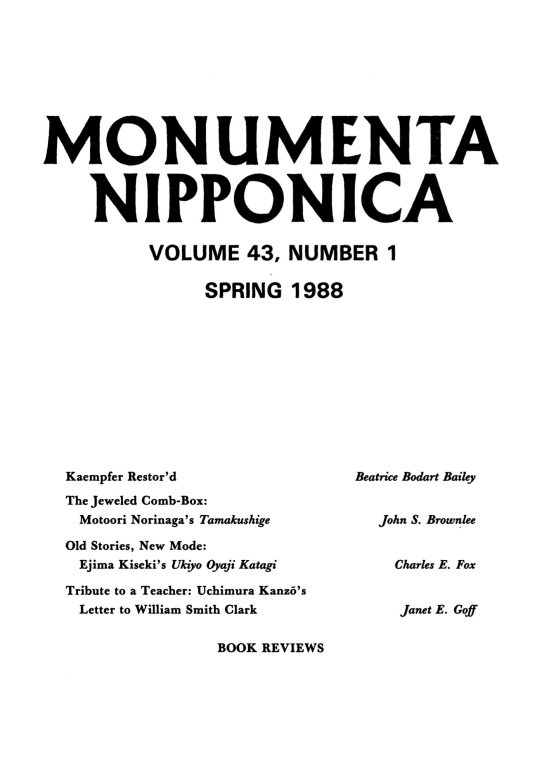 MN 43:1 (1988) 35–61The Jeweled Comb-Box: Motoori Norinaga’s TamakushigeJohn S. Brownlee
MN 43:1 (1988) 35–61The Jeweled Comb-Box: Motoori Norinaga’s TamakushigeJohn S. Brownlee MN 43:1 (1988) 45–61TamakushigeMotoori Norinaga, Translated by John S. Brownlee
MN 43:1 (1988) 45–61TamakushigeMotoori Norinaga, Translated by John S. Brownlee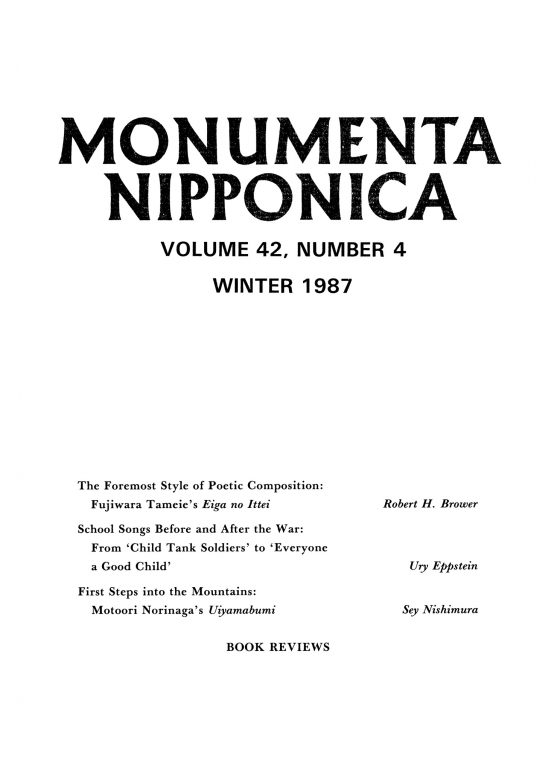 MN 42:4 (1987) 449–55First Steps into the Mountains: Motoori Norinaga’s UiyamabumiSey Nishimura
MN 42:4 (1987) 449–55First Steps into the Mountains: Motoori Norinaga’s UiyamabumiSey Nishimura MN 42:4 (1987) 456–93UiyamabumiMotoori Norinaga, Translated by Sey Nishimura
MN 42:4 (1987) 456–93UiyamabumiMotoori Norinaga, Translated by Sey Nishimura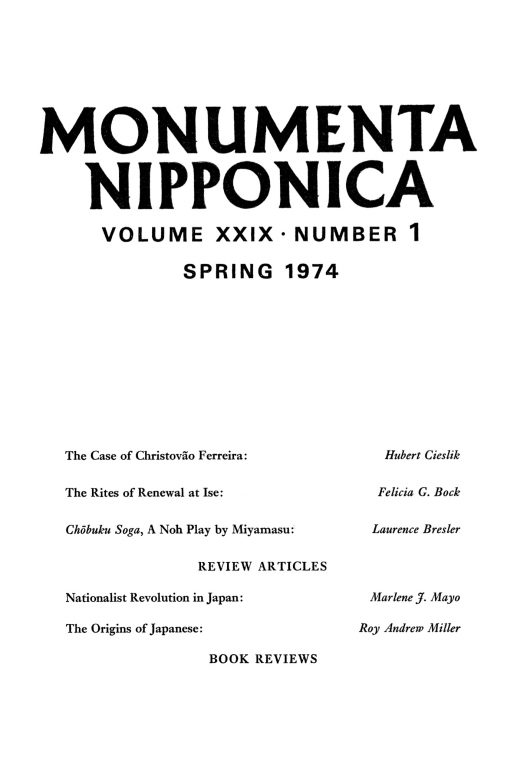 MN 29:1 (1974) 55–68The Rites of Renewal at IseFelicia Gressitt Bock
MN 29:1 (1974) 55–68The Rites of Renewal at IseFelicia Gressitt Bock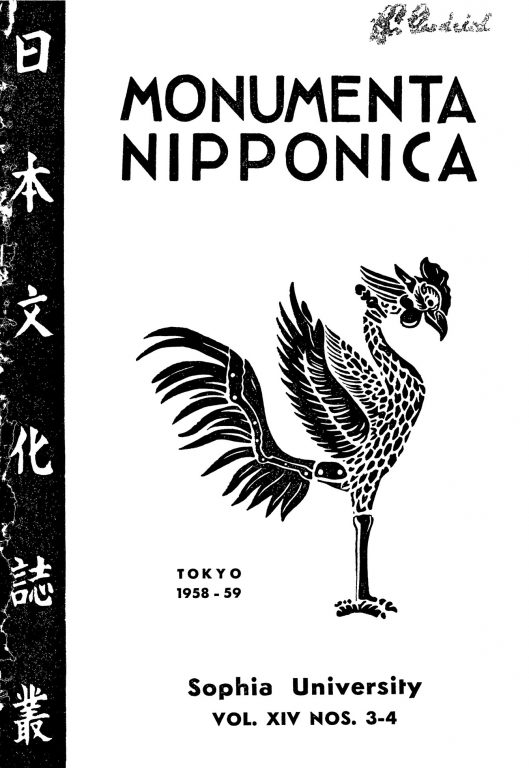 MN 14:3/4 (1958) 384–407Some Notes on the God Susa-no-oCornelius Ouwehand
MN 14:3/4 (1958) 384–407Some Notes on the God Susa-no-oCornelius Ouwehand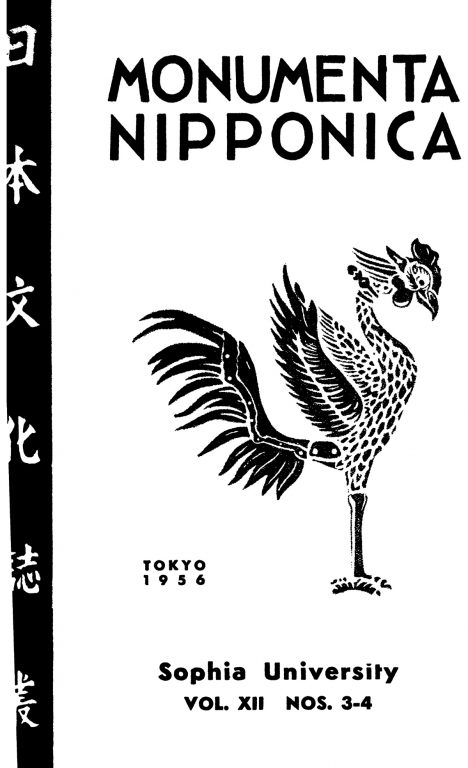 MN 12:3/4 (1956) 269–98Kamo Mabuchis Erklärung des Norito zum Toshi-goi-no-matsuri (Part 2)Kamo no Mabuchi, Translated by Heinrich Dumoulin
MN 12:3/4 (1956) 269–98Kamo Mabuchis Erklärung des Norito zum Toshi-goi-no-matsuri (Part 2)Kamo no Mabuchi, Translated by Heinrich Dumoulin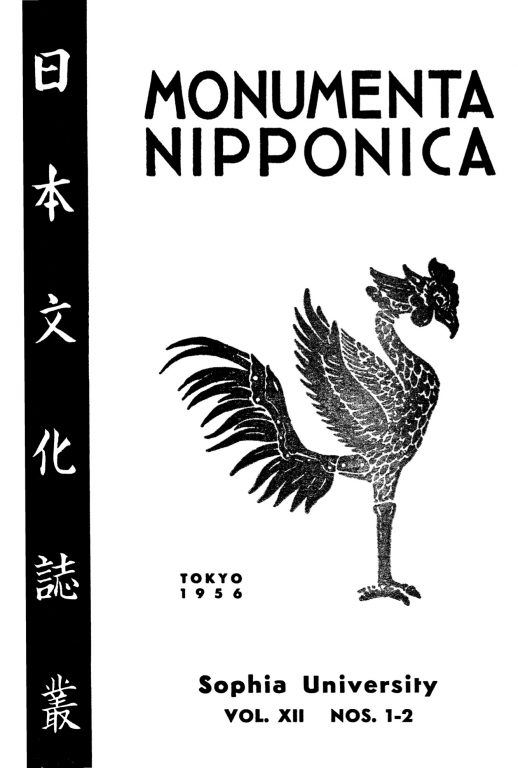 MN 12:1/2 (1956) 51–63Verwünschung in der altjapanischen KultspracheAnton Lämmerhirt
MN 12:1/2 (1956) 51–63Verwünschung in der altjapanischen KultspracheAnton Lämmerhirt MN 12:1/2 (1956) 121–56Kamo Mabuchis Erklärung des Norito zum Toshi-goi-no-matsuri (Part 1)Kamo no Mabuchi, Translated by Heinrich Dumoulin
MN 12:1/2 (1956) 121–56Kamo Mabuchis Erklärung des Norito zum Toshi-goi-no-matsuri (Part 1)Kamo no Mabuchi, Translated by Heinrich Dumoulin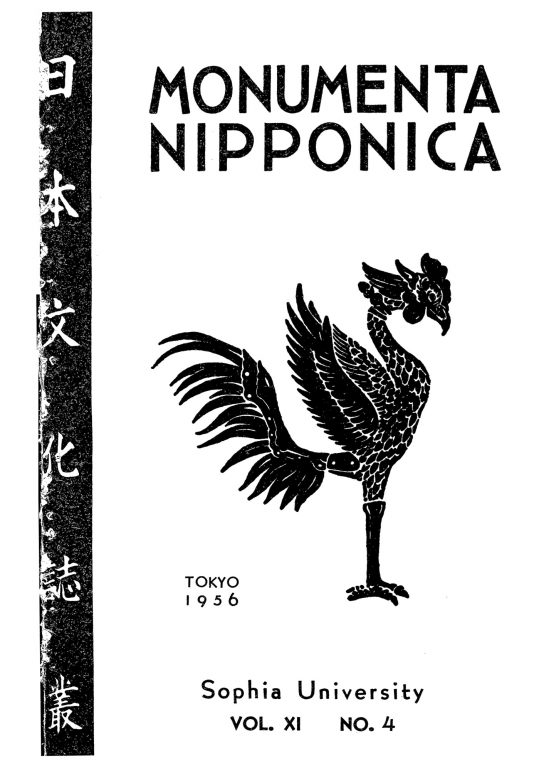 MN 11:4 (1956) 356–96Gebet in der altjapanischen KultspracheAnton Lämmerhirt
MN 11:4 (1956) 356–96Gebet in der altjapanischen KultspracheAnton Lämmerhirt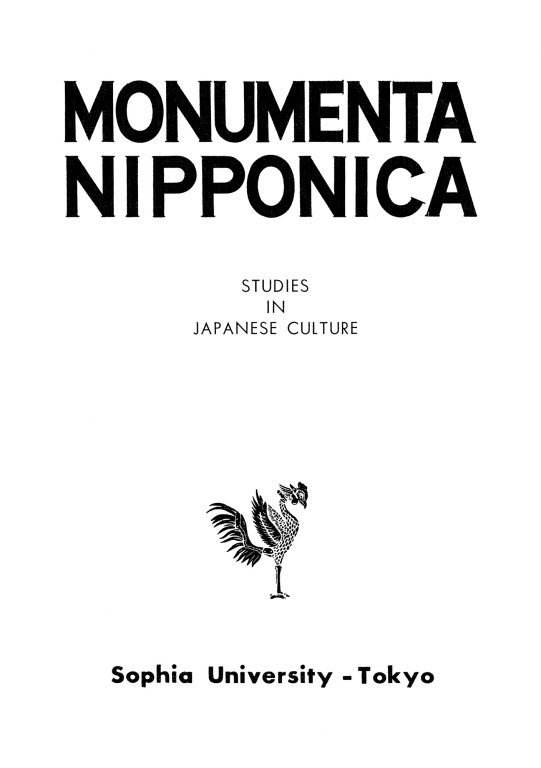 MN 10:1/2 (1954) 107–26The Sumu-Sanu Myth: Notes and Remarks on the Jimmu Tennō MythBoleslaw Szczesniak
MN 10:1/2 (1954) 107–26The Sumu-Sanu Myth: Notes and Remarks on the Jimmu Tennō MythBoleslaw Szczesniak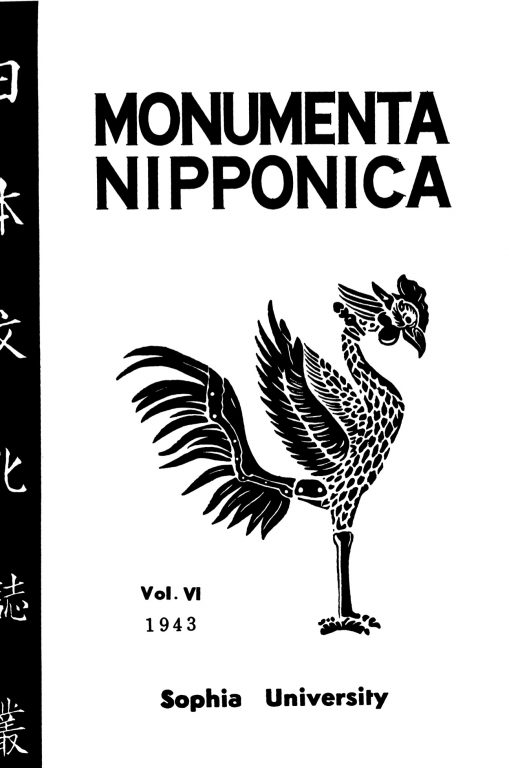 MN 6:1/2 (1943) 146–71in der altjapanischen Literatur: Hochsprache und Mundarten der NaraperiodeOtto Karow
MN 6:1/2 (1943) 146–71in der altjapanischen Literatur: Hochsprache und Mundarten der NaraperiodeOtto Karow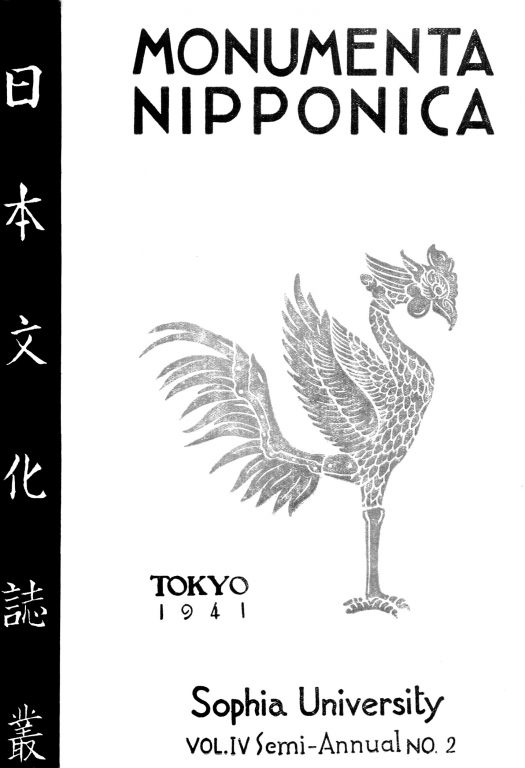 MN 4:2 (1941) 351–94The Meaning of Kami, Chapter III: Kami Considered as ManaD. C. Holtom
MN 4:2 (1941) 351–94The Meaning of Kami, Chapter III: Kami Considered as ManaD. C. Holtom MN 4:2 (1941) 486–96Massen-NukemairiHermann Bohner
MN 4:2 (1941) 486–96Massen-NukemairiHermann Bohner MN 4:2 (1941) 488–96BerichtTranslated by Hermann Bohner
MN 4:2 (1941) 488–96BerichtTranslated by Hermann Bohner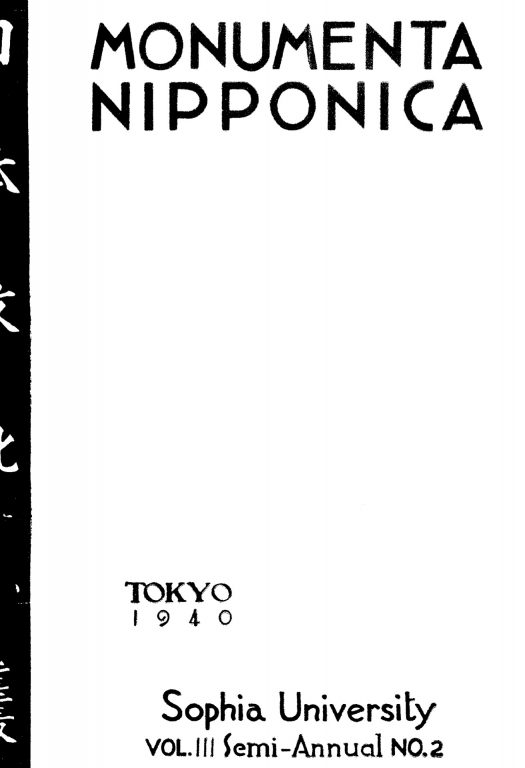 MN 3:2 (1940) 369–91Kannagara no MichiShōzō Kōno
MN 3:2 (1940) 369–91Kannagara no MichiShōzō Kōno MN 3:2 (1940) 392–413The Meaning of Kami, Chapter II: Interpretations by Japanese WritersD. C. Holtom
MN 3:2 (1940) 392–413The Meaning of Kami, Chapter II: Interpretations by Japanese WritersD. C. Holtom MN 3:2 (1940) 590–609Sō-gakkō-kei: Kada Azumamaro’s Gesuch um die Errichtung einer Kokugaku-SchuleHeinrich Dumoulin
MN 3:2 (1940) 590–609Sō-gakkō-kei: Kada Azumamaro’s Gesuch um die Errichtung einer Kokugaku-SchuleHeinrich Dumoulin MN 3:2 (1940) 596–609Sō-gakkō-keiKada no Azumamaro, Translated by Heinrich Dumoulin
MN 3:2 (1940) 596–609Sō-gakkō-keiKada no Azumamaro, Translated by Heinrich Dumoulin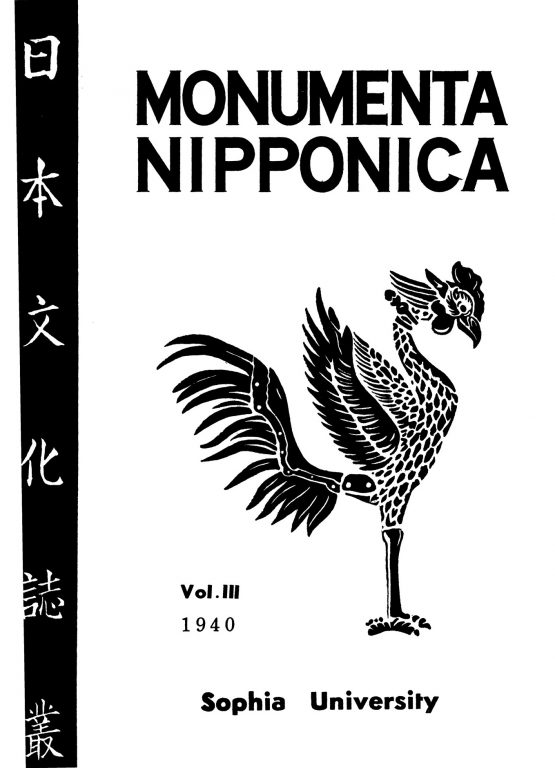 MN 3:1 (1940) 109–26Die Feuerberuhigungszeremonie des Shintō (Chinka-sai)Karl Reitz
MN 3:1 (1940) 109–26Die Feuerberuhigungszeremonie des Shintō (Chinka-sai)Karl Reitz MN 3:1 (1940) 182–239Yuiitsu-Shintō Myōbō-Yōshū. Lehrabriss des Yuiitsu-ShintōHeinrich Dumoulin and Tomonobu Ishibashi
MN 3:1 (1940) 182–239Yuiitsu-Shintō Myōbō-Yōshū. Lehrabriss des Yuiitsu-ShintōHeinrich Dumoulin and Tomonobu Ishibashi MN 3:1 (1940) 187–239Yuiitsu-Shintō Myōbō-YōshūTranslated by Tomonobu Ishibashi and Heinrich Dumoulin
MN 3:1 (1940) 187–239Yuiitsu-Shintō Myōbō-YōshūTranslated by Tomonobu Ishibashi and Heinrich Dumoulin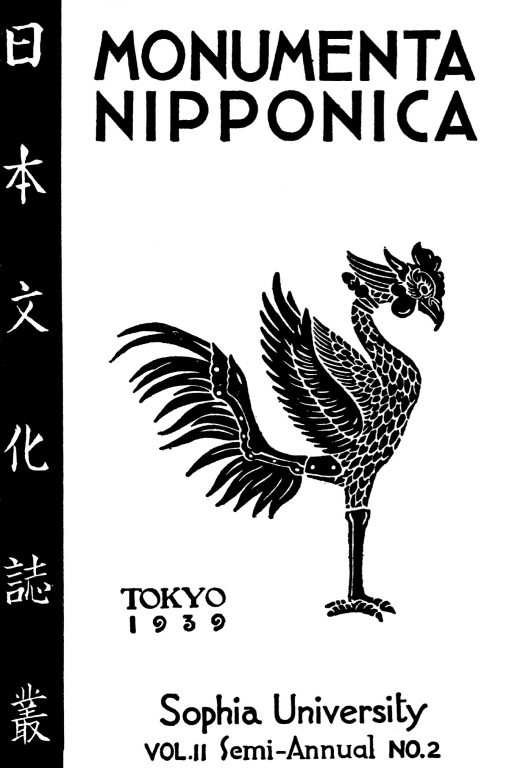 MN 2:2 (1939) 518–535Some Mikuji of Fushimi Inari JinjaDaniel C. Buchanan
MN 2:2 (1939) 518–535Some Mikuji of Fushimi Inari JinjaDaniel C. Buchanan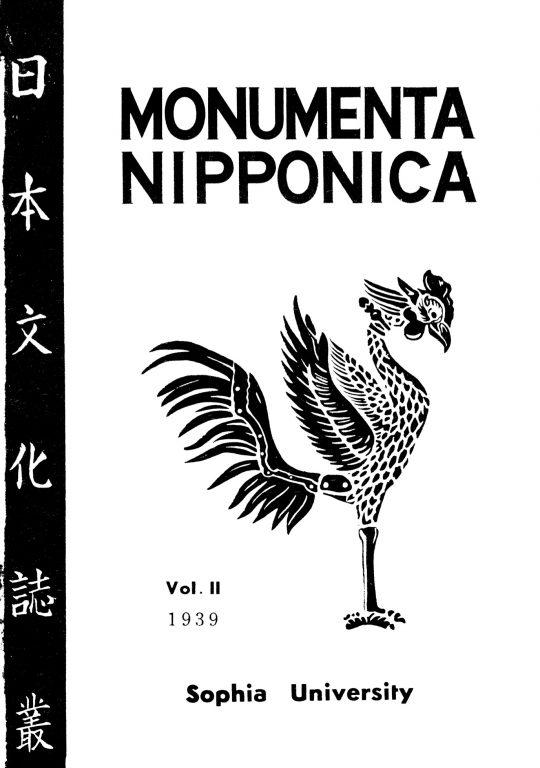 MN 2:1 (1939) 140–64Die Entwicklung der Kokugaku. Dargestellt in ihren HauptvertreternHans Stolte, Heinrich Dumoulin and Wilhelm Schiffer
MN 2:1 (1939) 140–64Die Entwicklung der Kokugaku. Dargestellt in ihren HauptvertreternHans Stolte, Heinrich Dumoulin and Wilhelm Schiffer MN 2:1 (1939) 165–92Kamo Mabuchi: Kokuikō. Gedanken über den “Sinn des Landes”Kamo no Mabuchi, Translated by Heinrich Dumoulin
MN 2:1 (1939) 165–92Kamo Mabuchi: Kokuikō. Gedanken über den “Sinn des Landes”Kamo no Mabuchi, Translated by Heinrich Dumoulin MN 2:1 (1939) 193–211Motoori Norinaga: Naobi no Mitama. Geist der ErneuerungMotoori Norinaga, Translated by Hans Stolte
MN 2:1 (1939) 193–211Motoori Norinaga: Naobi no Mitama. Geist der ErneuerungMotoori Norinaga, Translated by Hans Stolte
































